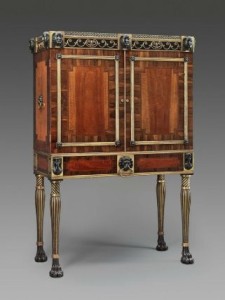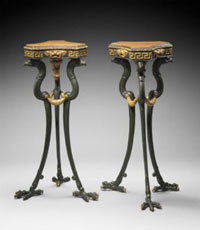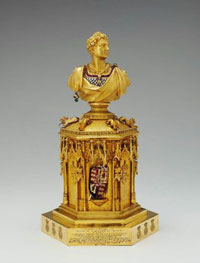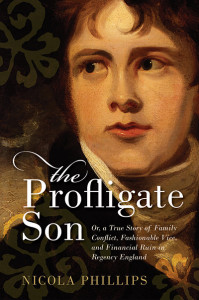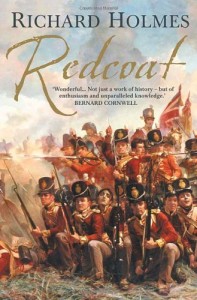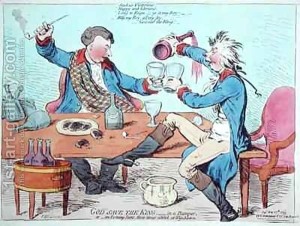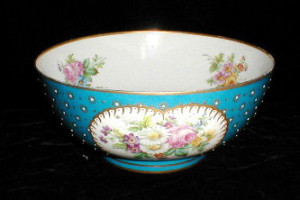Having finally finished the clean-up from Thanksgiving (the wedding crystal goblets I have to wash by hand tend to decorate the kitchen counter for days), I am now looking ahead to the next holidays, and more meals to be planned in celebration. Special occasions and special food always go together. Do you have a traditional holiday food you make or fondly remember? For Christians, this past Sunday was the first Sunday in Advent, the season leading up to Christmas, and in some parts of England, is also known as “stir-up day” –the day you are supposed to stir-up the batter for your Christmas cake or pudding so it will have enough time to age properly. (The day can also be the last Sunday before the start of Advent.) There’s a double meaning to the name, as one of the old texts used by the church for the start of Advent begins “Stir up , we beseech thee O Lord” and one site claims “this activity of stirring-up the ingredients symbolizes our hearts that must be stirred in preparation for Christ’s birth.” Christmas cakes (aka fruitcakes) have a pedigree as long as the technique of using rum or brandy to preserve food. “Plum Pudding” was also around long before the Victorians popularized it as “Christmas pudding”. Either one could include meat with the dried fruit in their early forms, but one is baked and the other was boiled –steamed in later times.
For someone who’s not a great cook, maybe it’s ironic that I’ve always been interested in period food, but it comes honestly from my interest in the daily life of other times. The Regency isn’t my only pet period –I’m a member of the Society for Creative Anachronism and indulge in medieval interests, too. I collect cookbooks on period food, and recently added Dinner with Tom Jones: Eighteenth Century Cookery Adapted for the Modern Kitchen, by Lorna Sass (1977, the Metropolitan Museum of Art). Sass also wrote To the King’s Taste (Richard II) and To the Queen’s Taste (Elizabeth I).
 I can’t believe I found this treasure in my church yard sale!! I recommend it as a research gold-mine; it has notes about menus, how dishes should be arranged on the table, and all sorts of extra goodies besides the recipes, and while it covers a period slightly earlier than our beloved Regency, back then things did not change as rapidly as they do now. Casting about for what to feed our characters, a ragoo of asparagus or heavens, yes, a chocolate tart(!) might be just the thing we need to serve them. And the book is illustrated with delightful sketches of county life by Thomas Rowlandson (behaving properly for a change).
I can’t believe I found this treasure in my church yard sale!! I recommend it as a research gold-mine; it has notes about menus, how dishes should be arranged on the table, and all sorts of extra goodies besides the recipes, and while it covers a period slightly earlier than our beloved Regency, back then things did not change as rapidly as they do now. Casting about for what to feed our characters, a ragoo of asparagus or heavens, yes, a chocolate tart(!) might be just the thing we need to serve them. And the book is illustrated with delightful sketches of county life by Thomas Rowlandson (behaving properly for a change).
 On my Christmas list is another cookbook just released last month which should also be of great interest to us all —Dinner with Mr Darcy by Pen Vogler, a new addition to the existing canon related to food in Jane Austen’s books and life. Besides recipes inspired by Jane’s novels and letters, it also promises notes about table arrangements, kitchens and gardens, changing mealtimes, and servants and service, etc.
On my Christmas list is another cookbook just released last month which should also be of great interest to us all —Dinner with Mr Darcy by Pen Vogler, a new addition to the existing canon related to food in Jane Austen’s books and life. Besides recipes inspired by Jane’s novels and letters, it also promises notes about table arrangements, kitchens and gardens, changing mealtimes, and servants and service, etc.
Both of these books use Hannah Glasse’s first cookbook, The Art of Cookery Made Plain and Easy (1747), as a chief source. A reviewer of Vogler’s book (http://tinyurl.com/mlrxl6j) says this was “one of the first commercial cookbooks to capture the public imagination and was used by middle-class families like the Austens well into the 19th century.” Does food history interest you? Do you care about what our story characters eat? (The book I’m editing now for reissue, The Captain’s Dilemma, has a running joke about the family’s inventive but not very good cook.) What are some of your favorite resources?
I wish you all very happy holidays and some memorable meals with friends and family, whatever you celebrate!

Mr Collins (Tom Hollander) distracts Elizabeth Bennett (Keira Knightley) from her meal in the 2005 ‘Pride and Prejudice’ -Photo Credit: Rex Features/Everett Collection

